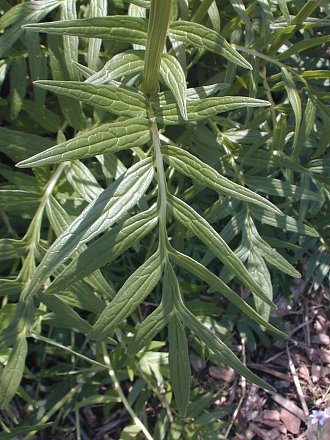
The central stem terminates in one or more flat-topped panicles of flowers about 2-5" across. On a robust plant, stalks of smaller flat-topped panicles may be produced from the axils of 1-2 pairs of upper leaves. The peduncles and pedicels of these panicles are light green (less often dark red) and either glabrous or pubescent. Individual trumpet-shaped flowers are about 4 mm. (3/16" ) long, consisting of a light pink or white corolla with 5 spreading lobes, a short green calyx with 5 teeth, 3 stamens, and a pistil with a style that is tripartite at its tip. The blooming period occurs during the summer for a month or two; the flowers are fragrant. Afterwards, the flowers are replaced by achenes with feathery hairs. The achenes are about 4 mm. (3/16") long, lanceoloid in shape, and slightly flattened; they are distributed by the wind. The root system is fibrous and rhizomatous. Colonies of clonal plants are sometimes produced by the rhizomes.
Cultivation: The preference is full sun, consistently moist conditions, and soil consisting of fertile loam. However, this plant can adapt to less ideal circumstances. There are very few problems with disease organisms or pests.

Range & Habitat: The non-native Garden Valerian has naturalized in NE Illinois, where it is uncommon (see Distribution Map). It was introduced into North America from Europe as an ornamental and medicinal plant. Habitats consist of soggy thickets and meadows, fens, and roadside ditches. So far, Garden Valerian has not been a problem in Illinois, although in the northeastern states it appears to be more abundant and aggressive, possibly because of the cooler climate and more abundant rainfall in these states.
Faunal Associations: According to Müller (1873/1883), the nectar and pollen of the flowers attract honeybees, bumblebees, Halictid bees, dance flies (Empididae), flower flies (Syrphidae), Muscid flies, blow flies (Calliphoridae), flesh flies (Sarcophagidae), and thick-headed flies (Conopidae). The flowers also attract skippers and butterflies during the day (personal observation), and perhaps moths at night. Because of its bitter taste and other properties, the foliage of Garden Valerian is not attractive to mammalian herbivores.
Photographic Location: A flower garden at the Arboretum of the University of Illinois in Urbana, Illinois.
Comments: This interesting plant has attractive foliage and flowers, therefore it is no surprise that it is occasionally cultivated in flower gardens; it is also cultivated in medicinal herb gardens. When the pulverized roots of Garden Valerian are consumed, they exert hypnotic, sedative, and anti-spasmodic effects in the human body. It is thought that neurologically active chemicals in the roots affect the GABA neurotransmitter system and possibly other neurotransmitter systems within the brain to produce these effects. Unlike native Valeriana spp. (Valerian species), Garden Valerian has odd-pinnate leaves (or deeply pinnatifid leaves) from top to bottom. The lower leaves of native Valerian species are either undivided or less so.